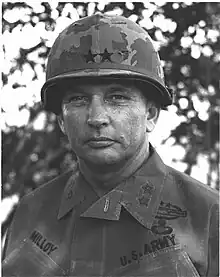Albert Ernest Milloy | |
|---|---|
 Milloy as commander of 1st Infantry Division | |
| Nickname(s) | Ernie |
| Born | 25 November 1921 Hattiesburg, Mississippi |
| Died | 3 June 2012 (aged 90) Henderson, Nevada |
| Buried | |
| Allegiance | United States of America |
| Service/ | |
| Years of service | 37 |
| Rank | |
| Commands held | John F. Kennedy Special Warfare Center and School 1st Infantry Division 23rd Infantry Division |
| Battles/wars | World War II Korean War Vietnam War |
| Awards | Distinguished Service Medal Silver Star (3) Legion of Merit (2) Distinguished Flying Cross Bronze Star (3) Combat Infantryman Badge (3) |
Major General Albert E. Milloy (25 November 1921 – 3 June 2012) was a United States Army officer who served in World War II, the Korean War and the Vietnam War.
Early life
He was born on 25 November 1921 in Hattiesburg, Mississippi.
Military career
Albert began his military career in 1938 when he enlisted in the U.S. Army at the age of 17 as a private, serving in the Mississippi National Guard
In 1940 he was assisting a relative in running a Dr. Pepper bottling plant in Louisiana when he was asked to assist in standing up a new regular army unit. Milloy would subsequently serve as an infantry platoon leader in Camp Blanding, Florida prior to the outbreak of war in 1941.
During World War II he served in the 504th Parachute Infantry Regiment.[1] Seeing action in the Mediterranean and Western European Theater, Milloy would serve as the commander of Company C, 504th PIR seeing combat in Italy, France, the Netherlands, and Germany. He would conduct three combat jumps with the 82nd Airborne Division, and be awarded the Silver Star for actions in Altavilla. [2]
During the Korean War he served as a Major in the 2nd Infantry Division.[3] Commanding 2nd Battalion of the 38th Regiment, he led his men through the Chinese spring offensive, the "Punch Bowl" and "Heartbreak Ridge," and be awarded two more Silver Stars.
He commanded the 2nd Brigade, 1st Infantry Division in South Vietnam in early 1966, leading it in Operation Mastiff and Operation Mallett.[4]
He served as commander of the John F. Kennedy Special Warfare Center and School from 1966 to 1968.[5]
In August 1969 he assumed command of the 1st Infantry Division in South Vietnam. He led the division until its departure from South Vietnam on 4 April 1970. He rejected the idea of a divisional farewell march from Lai Khe to Long Binh Post. The division instead carved a 1.5 miles (2.4 km) long by 1 mile (1.6 km) wide 1 into the jungle east of the Michelin Rubber Plantation.[6]
On 21 March 1970 he was appointed as commander of the 23rd Infantry Division, replacing Major General Lloyd B. Ramsey, who had been injured in a helicopter crash.[7] He served as commander until November 1970, during this time he dealt with the aftermath of the Mỹ Lai massacre, which had been conducted by units of the division. He advised congressional investigators that Mỹ Lai was insecure and infested with mines and booby-traps.[8] He was later described by his subordinate Norman Schwarzkopf as “the kind of muddy-boots commander I admired.”[9]
Milloy would finish his career as the U.S. Army Chief of Staff at the Presidio of San Francisco retiring in 1975.
Later life
Following his retirement he would work as a licensed general contractor in California, owning several small businesses.
He died on 3 June 2012 and was buried in Arlington National Cemetery.
Decorations
His decorations include the Distinguished Service Medal (2), Silver Star (3), Legion of Merit (2), Distinguished Flying Cross, Bronze Star (3) Purple Heart (2) and Air Medal (20).
References
- ↑ van Lunteren, Frank (2014). The Battle of the Bridges: The 504 Parachute Infantry Regiment in Operation Market Garden. Casemate. p. 93. ISBN 9781612002323.
- ↑ Nordyke, Phil (2005). All American, All the Way: The Combat History of the 82nd Airborne Division in World War II. Zenith Press. p. 118.
- ↑ "Albert Milloy". Military Times Hall of Valor. Retrieved 27 September 2021.
- ↑ Carland, John (1999). Combat Operations: Stemming the Tide, May 1965 to October 1966. Government Printing Office. pp. 175–9. ISBN 9780160873102.
 This article incorporates text from this source, which is in the public domain.
This article incorporates text from this source, which is in the public domain. - ↑ Eugene Piasecki (2014). "the Special Forces Soldier". Retrieved 27 September 2021.
- ↑ "Departing Division Leaves its mark in Vietnam". The New York Times. 5 April 1970.
- ↑ "Vietnam Unit Gets Chief". The New York Times. 22 March 1970.
- ↑ Investigation of the My Lai Incident: Hearings of the Armed Services Investigating Subcommittee of the Committee on Armed Services, House of Representatives, Ninety-first Congress, Second Session. United States Congress. 1976. pp. 743–6.
- ↑ Schwarzkopf, Norman (2010). It Doesn't Take a Hero: The Autobiography of General Norman Schwarzkopf. Random House. p. 194. ISBN 9780307764997.